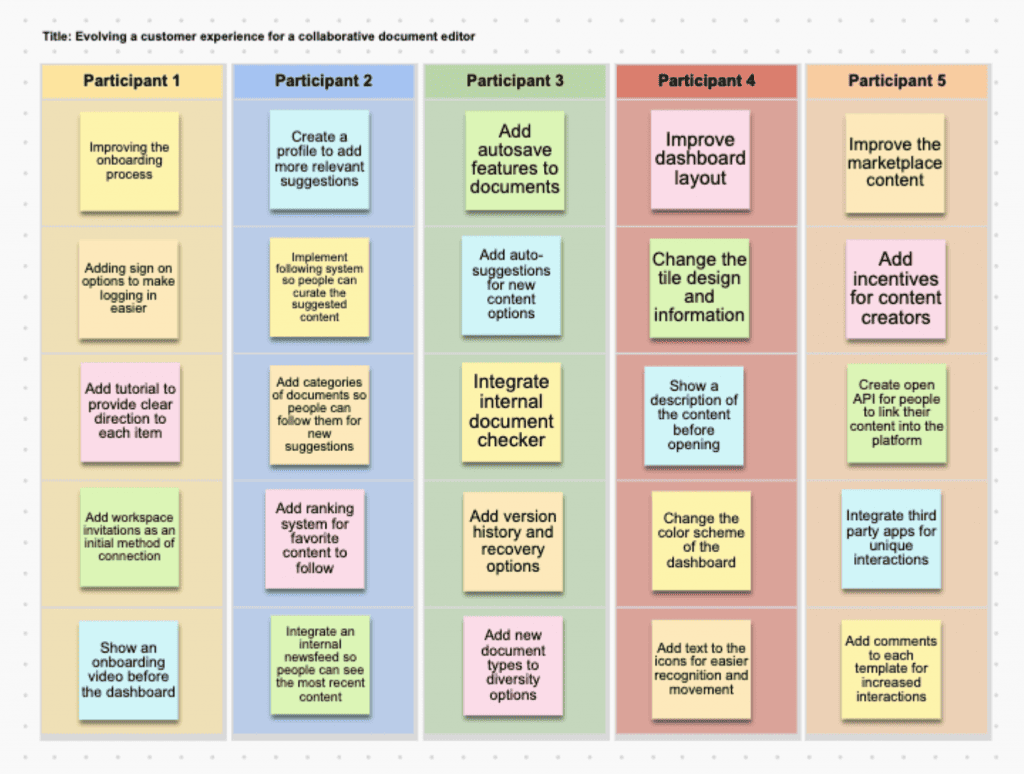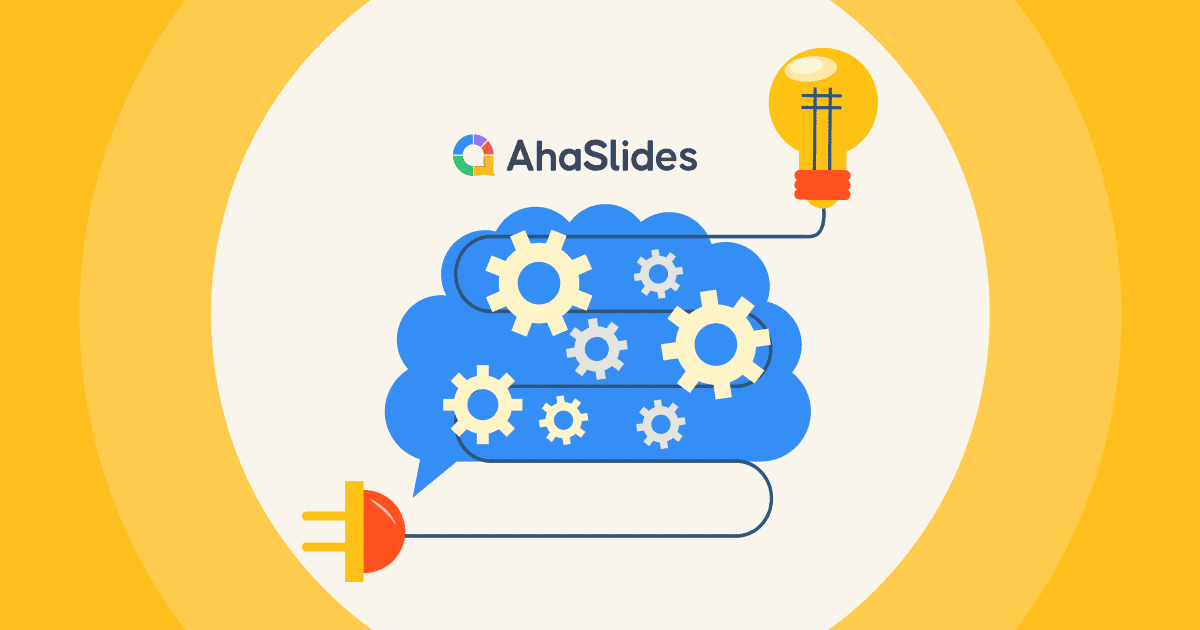Can we become more creative with brainwriting?
Using some brainstorming techniques can be a helpful way to generate innovative and creative ideas. But the time seems right for you to consider switching from brainstorming to Brainwriting sometimes.
It is a practical tool that doesn't require a lot of financial resources but can be the best classic brainstorming alternative to promote inclusivity, diversity of perspectives, and more effective problem-solving.
Let's check out what brainwriting is, its pros and cons, and the best strategy to use it, plus some practical examples.

Tips for Better Engagement
- 8 Ultimate Mind Map Makers with Best Pros, Cons, Pricing in 2025
- Best SWOT Analysis Examples | What It is & How to Practice in 2025
- Idea Board | Free Online Brainstorming Tool
- AI Online Quiz Creator | Make Quizzes Live
- Host Free Live Q&A
- AhaSlides online poll maker

Need new ways to brainstorm?
Use fun quiz on AhaSlides to generate more ideas at work, in class or during gatherings with friends!
🚀 Sign Up For Free☁️
Table of Contents
- What is Brainwriting?
- Brainwriting: Pros and Cons
- Ultimate guide to conduct brainwriting effectively
- Uses and Examples of Brainwriting
- Key Takeaways
What is Brainwriting?
Introduced in 1969 in a German magazine by Bernd Rohrbach, Brainwriting soon became widely used as a powerful technique for teams to generate ideas and solutions quickly and efficiently.
It is a collaborative brainstorming method that focuses on written communication rather than verbal communication. The process involves a group of individuals sitting together and writing down their ideas on a piece of paper. The ideas are then passed around the group, and each member builds on the ideas of the others. This process continues until all the participants have had a chance to contribute their ideas.
However, traditional brainwriting can be time-consuming and may not be suitable for larger groups. That's where 635 brainwriting comes into play. The 6-3-5 technique is a more advanced strategy used in brainstorming, as it involves a group of six individuals who write down three ideas each in five minutes, for a total of 15 ideas. Then, each participant passes their sheet of paper to the person on their right, who adds three more ideas to the list. This process continues until all six participants have contributed to each other's sheets, resulting in a total of 90 ideas.

Brainwriting: Pros and Cons
Like any variation of brainstorming, brainwriting has both pros and cons and carefully looking at its advantages and limitations can help you know when and how to apply the technique to solve your problems and generate more innovative ideas.
Pros
- Allows all members of a team to contribute equally while reducing the groupthink phenomenon, individuals are not influenced by the opinions or ideas of others.
- Foster greater inclusivity and diversity of perspectives. Unlike traditional brainstorming sessions where the loudest voice in the room tends to dominate, brainwriting ensures that everyone's ideas are heard and valued.
- Eliminates the pressure of having to come up with ideas on the spot, which can be intimidating for some individuals. Participants who may be more introverted or less comfortable speaking up in group settings can still contribute their ideas through written communication.
- Allows team members to take their time, think through their ideas, and express them in a clear and concise manner. By building on the ideas of others, team members are able to come up with unique and unconventional solutions to complex problems.
- As team members are writing down their ideas simultaneously, the process can generate a large number of ideas in a short amount of time. This can be especially useful in situations where time is of the essence, such as during a product launch or marketing campaign.
Cons
- Leads to the generation of a large number of ideas, but not all of them are practical or feasible. Since everyone in the group is encouraged to contribute their ideas, there is a risk of generating irrelevant or impractical suggestions. This can lead to time wastage and may even confuse the team.
- Discourages spontaneous creativity. Brainwriting works by generating ideas in a structured and organized manner. This can sometimes limit the creative flow of spontaneous ideas that may arise during a regular brainstorming session.
- Requires a lot of preparation and organization. The process involves distributing sheets of paper and pens, setting up a timer, and ensuring that everyone has a clear understanding of the rules. This can be time-consuming and may not be suitable for impromptu brainstorming sessions.
- There is less opportunity for interaction and discussion among team members due to its independent processing. This can lead to a lack of refinement or development of ideas, as well as may limit opportunities for team bonding and relationship building.
- While brainwriting reduces the likelihood of groupthink, individuals may still be subject to their own biases and assumptions when generating ideas.
Ultimate Guide to Conduct Brainwriting Effectively
- Define the problem or topic for which you are conducting the brainwriting session. This should be communicated to all team members prior to the session.
- Set a time limit for the brainstorming session. This will ensure that everyone has enough time to generate ideas, but also prevents the session from becoming too long and unfocused.
- Explain the process to the team which includes how long the session will last, how ideas should be recorded, and how the ideas will be shared with the group.
- Distribute the brainwriting template to each team member. The template should include the problem or topic at the top, and space for team members to record their ideas.
- Set the ground rules. This includes rules around confidentiality (ideas should not be shared outside of the session), the use of positive language (avoid criticizing ideas), and a commitment to stay on-topic.
- Start the session by setting the timer for the allotted time. Encourage team members to write down as many ideas as possible within the time limit. Remind team members that they should not share their ideas with others during this phase.
- Once the time limit has elapsed, collect the brainwriting templates from each team member. Make sure to collect all the templates, even those with just a few ideas.
- Share the ideas. This can be done by having each team member read their ideas aloud, or by collecting the templates and compiling the ideas into a shared document or presentation.
- Encourage team members to build on each other's ideas and suggest improvements or modifications, discuss and refine the ideas. The goal is to refine the ideas and come up with a list of actionable items.
- Select and Implement the best ideas: This can be done by voting on the ideas, or by having a discussion to identify the most promising ideas. Assign tasks to team members to bring the ideas to fruition and set deadlines for completion.
- Follow-ups: Check in with team members to ensure that the tasks are being completed, and to identify any roadblocks or issues that may arise.
HINTS: Using all-in presentation tools like AhaSlides can help you optimize brainwiritng process with others and time-saving.

Uses and Examples of Brainwriting
Brainwriting is a versatile technique that can be used in a wide range of industries and settings. Here are some examples of using brainwriting in specific fields.
Problem-solving
It can be used to solve problems within an organization or a team. By generating a large number of ideas, the technique can help identify potential solutions that may not have been considered before. Let's say that a team is tasked with solving the problem of high employee turnover in a company. They decide to use the brainwriting technique to generate ideas for how to reduce turnover.
Product development
This technique can be utilized in product development to generate ideas for new products or features. This can help ensure that the products meet the needs of customers and are innovative. For example, in product design, brainwriting can be used to generate ideas for new products, identify potential design flaws, and develop solutions to design challenges.
Marketing
Marketing field can leverage brainwriting to generate ideas for marketing campaigns or strategies. This can help companies to create effective marketing messages and reach their target audience. For example, brainwriting can be used to develop new advertising campaigns, identify new target markets, and create innovative branding strategies.
Innovation
Brainwriting can be used to promote innovation within an organization. By generating a large number of ideas, brainwriting can help identify new and innovative products, services, or processes. For example, in healthcare, brainwriting can be used to develop new treatment plans, identify potential side effects of medications, and explore new approaches to patient care.
Training
In training sessions, brainwriting can be used to encourage team members to think creatively and come up with new ideas. This can help develop critical thinking skills and promote teamwork.
Quality improvement
In quality improvement initiatives, using Brainwriting helps to generate ideas for improving processes, reducing waste, and increasing efficiency. This can help companies save time and resources and improve their bottom line.
Key Takeaways
Whether you are working on a team project or trying to come up with innovative solutions on your own, brainwriting techniques can help you generate fresh ideas and overcome creative challenges. While brainwriting has its advantages, it also has its limitations. To overcome these limitations, it is essential to combine the technique with other brainstorming techniques and tools like AhaSlides and to tailor the approach to suit the specific needs of the team and organization.








